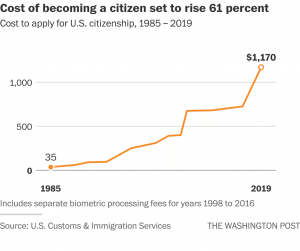NOVEMBER 13, 2019

The cost of U.S. citizenship would jump 61 percent under a proposal the Trump administration contends reflects the true cost of the process but that far outpaces inflation.
 The Department of Homeland Security wants to increase the application fee to $1,170, according to a notice to be published Thursday in the Federal Register, and end a program that secures reduced fees for low-income applicants. The agency also wants to impose a fee, for the first time, on some asylum seekers; only Fiji, Australia and Iran do that now.
The Department of Homeland Security wants to increase the application fee to $1,170, according to a notice to be published Thursday in the Federal Register, and end a program that secures reduced fees for low-income applicants. The agency also wants to impose a fee, for the first time, on some asylum seekers; only Fiji, Australia and Iran do that now.
The announcement comes the same week the U.S. Supreme Court heard arguments to decide the fate of the Deferred Action for Childhood Arrivals (DACA) program, an Obama-era initiative the White House would like to scrap. DACA shields from deportation some undocumented immigrants who were brought to the United States as children.
In real terms, the proposed changes would make the citizenship application fee equivalent of nearly 2 percent of the median household income — or about one week’s pay for the typical American household — its highest level on record. Had the application fee risen with the pace of inflation, it would be $85 today.
 “This proposed adjustment in fees would ensure more applicants cover the true cost of their applications and minimizes subsidies from an already over-extended system,” acting U.S. Citizenship and Immigration Services director Ken Cuccinelli said in a statement. The agency says that under the current fee structure it is underfunded approximately $1.3 billion a year.
“This proposed adjustment in fees would ensure more applicants cover the true cost of their applications and minimizes subsidies from an already over-extended system,” acting U.S. Citizenship and Immigration Services director Ken Cuccinelli said in a statement. The agency says that under the current fee structure it is underfunded approximately $1.3 billion a year.
Boundless, an immigration services firm, said in a statement that the move is just another anti-immigration tactic by the Trump administration. Median household income for non-citizens is significantly lower than for the native-born, meaning the proposed fee increase could pose a significant hardship.
“Once again, this administration is attempting to use every tool at its disposal to restrict legal immigration and even U.S. citizenship,” said Doug Rand, the group’s co-founder. “It’s an unprecedented weaponization of government fees.”
The administration has attempted to impose strict requirements on legal immigration in the past, often running afoul of the judicial branch in the process. In recent months, for instance, federal courts blocked the administration from implementing a “public charge” rule that would make it harder for immigrants to get green cards if officials believed they were likely to require public assistance. A federal court also blocked a proposed rule that would require would-be immigrants to obtain health insurance within 30 days of arriving in the country.
The administration’s focus on making immigration harder is vexing to experts in the fields of public policy and economics, where the longstanding consensus is that societies benefit greatly from immigration. Higher levels of immigration are associated with greater economic growth, healthier government finances and greater economic innovation, data shows. Immigrants are also less likely to commit crimes than the native-born.
These trends are even more pronounced in societies, like the United States, where the native-born birth rate is low and falling. According to U.S. Census data, the current fertility rate of 1,765.5 lifetime births per 1,000 women is well below the 2,100 births needed to sustain the population. Without immigration, the U.S. population would be in decline.
Experts have noted with some alarm that in 2018, the immigrant population grew at its slowest pace in a decade, with the Trump administration’s hostility toward immigrants cited as a key factor.
Courtesy/Source: Washington Post










































































































